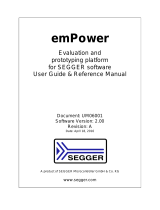
4.3 Debug Connector (DBG)
The debug connector serves a dual purpose, based on the debug mode, which can be set up using Simplicity Studio. If the "Debug IN"
mode is selected, the connector allows an external debugger to be used with the on-board EFM32PG23. If the "Debug OUT" mode is
selected, the connector allows the kit to be used as a debugger towards an external target. If the "Debug MCU" mode (default) is selec-
ted, the connector is isolated from the debug interface of both the board controller and the on-board target device.
Because this connector is automatically switched to support the different operating modes, it is only available when the board controller
is powered (J-Link USB cable connected). If debug access to the target device is required when the board controller is unpowered, this
should be done by connecting directly to the appropriate pins on the breakout header.
The pinout of the connector follows that of the standard ARM Cortex Debug 19-pin connector. The pinout is described in detail below.
Note that even though the connector supports JTAG in addition to Serial Wire Debug, it does not necessarily mean that the kit or the
on-board target device supports this.
12
4
8
6
10
5
9
12
13 14
11
15 16
17 18
20
19
TMS / SWDIO / C2D
TCK / SWCLK / C2CK
TDO / SWO
TDI / C2Dps
RESET / C2CKps
GND
NC
NC
GND
GND
GND
7
GND
VTARGET
Cable Detect
NC
NC
NC
NC
NC
NC
3
Figure 4.3. Debug Connector
Even though the pinout matches the pinout of an ARM Cortex Debug connector, these are not fully compatible as pin 7 is physically
removed from the Cortex Debug connector. Some cables have a small plug that prevents them from being used when this pin is
present. If this is the case, remove the plug, or use a standard 2x10 1.27 mm straight cable instead.
Table 4.4. Debug Connector Pin Descriptions
Pin Number(s) Function Note
1 VTARGET Target reference voltage. Used for shifting logical signal levels between target and
debugger.
2 TMS / SDWIO / C2D JTAG test mode select, Serial Wire data or C2 data
4 TCK / SWCLK / C2CK JTAG test clock, Serial Wire clock or C2 clock
6 TDO/SWO JTAG test data out or Serial Wire output
8 TDI / C2Dps JTAG test data in, or C2D "pin sharing" function
10 RESET / C2CKps Target device reset, or C2CK "pin sharing" function
12 NC TRACECLK
14 NC TRACED0
16 NC TRACED1
18 NC TRACED2
20 NC TRACED3
9 Cable detect Connect to ground
11, 13 NC Not connected
3, 5, 15, 17, 19 GND
UG515: EFM32PG23 Pro Kit User’s Guide
Connectors
silabs.com | Building a more connected world. Rev. 1.0 | 11
Downloaded from Arrow.com.Downloaded from Arrow.com.Downloaded from Arrow.com.Downloaded from Arrow.com.Downloaded from Arrow.com.Downloaded from Arrow.com.Downloaded from Arrow.com.Downloaded from Arrow.com.Downloaded from Arrow.com.Downloaded from Arrow.com.Downloaded from Arrow.com.




















